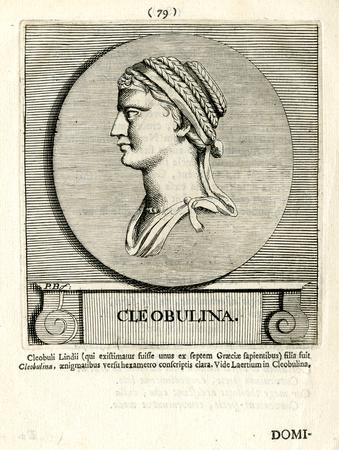In the archaic period, and together with Sappho, initiator of a female poetic tradition that lasted until the Roman period, we find Phemonoe, Damophyle, Charixene, the Spartans Hagesichora, Megalostrata and Mia, and the bucolic poetess Eriphanis.

Cleobulina of Lindos
s. VI a. e. c.; n. Lindos (Rodas)
Període d'activitat: 600 a. e. c. — 500 a. e. c.
Classificació geogràfica: Europa > Grècia Europa > Turquia
Moviments socio-culturals
Antiguitat > Cultura grega > Època arcaica
Grups per àmbit de dedicació
Escriptores > Poetes
Escriptores > en > grec (antic)
Context de creació femenina
Ressenya
Poetess born around 600 BC in the city of Lindos (Rhodes). She was the daughter of Cleobulus, one of the Seven Sages of Greece, who believed that women should receive a good education. She composed a kind of riddles in verse called “enigmas”, very short and written in distichs and hexameters, a fact that facilitated their oral diffusion. Four of them are preserved.
Justificacions
Biografia
Poetess born around 600 BC in the city of Lindos (Rhodes). She is always mentioned as the daughter of Cleobulus, one of the Seven Sages of Greece. Although Cleobulina is close to Sappho from a geographical and chronological point of view, nevertheless, she is far from her lyric poetry, since her riddles and enigmas belong to a gnomic tradition and are linked to a sapiential and proverbial literature of a markedly oral character.
She was cited by Aristotle in his Poetics and mentioned by Plutarch in The Banquet of the Seven Sages. The fabulist Aesop defends Cleobuline's intellectual acuity, in the face of the somewhat disparaging words of an interlocutor scornful of this "feminine" literature. Expressing oneself through riddles is, in the Greek sphere, something typical of women, who are weavers also with words.
Thales praised her for being a woman with the "mind of a statesman", for which he nicknamed her Eumetis, meaning "the clever one". Plutarch referred that her father had ruled Rhodes more fairly because of her influence. Cratinus composed a work entitled The Cleobulines, a clear sign of the poetess' popularity. This theatrical piece satirized her intellectual and counseling skills.
Four enigmas remain of her work; two are about everyday objects, one about the figure of the artist, and another about the year.
Bibliografia
- Capellà i Soler, Margarida (2004). Poetes gregues antigues. Barcelona: Publicacions de l’abadia de Montserrat, pp. 39-45.
- Gardella Hueso, Mariana y Juliá, Victoria (2018). El enigma de Cleobulina. Argentina: Teseo, (retrieved on 22/05/2021), <https://www.editorialteseo.com/archivos/15768/el-enigma-de-cleobulina/>
- Gardella Hueso, Mariana (2021): “Heráclito de Éfeso, Cleobulina de Lindos y la tradición de los enigmas”, en Revista de Filosofía 46 (1), 45-62, (retrieved on 10/06/2021),<https://revistas.ucm.es/index.php/RESF/article/view/75761/4564456557036>
- ”Entrevistas Mariana Gardella sobre Cleobulina de Lindos” (2021). Blog: Mulheres na Filosofia, (retrieved on 22/05/2021), <https://www.youtube.com/watch?v=i9NSDxVYoLk>
- Uzín Olleros, Angelina (2021). “Cleobulina de Lindos”, en Los enigmas de la filosofia, (retrieved on 22/05/2021), <https://www.youtube.com/watch?v=toIkTBQ8MVc>
- Luque, Aurora (2020), Grecorromanas. Lírica superviviente de la Antigüedad clásica. Barcelona: Planeta, pp. 73-77.
Enfocament Didàctic
-CUC: Block Classical roots of today's world. Everyday life; Block Continuity of cultural heritage. Literature (Poetry), art and science.
-Greek Baccalaureate: Block The text: comprehension and translation; Block Literary education.
-Universal Literature 1st Baccalaureate: Interpretation of Greek period fragments of different genres and themes.
-Spanish Language and Literature ESO: Literary Education Block.